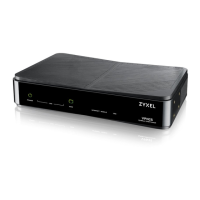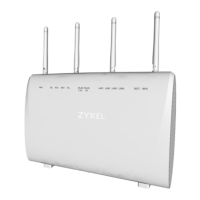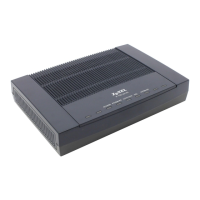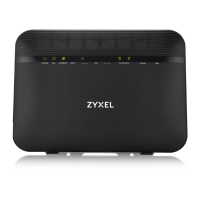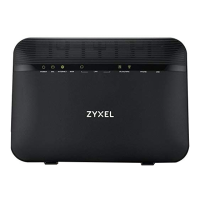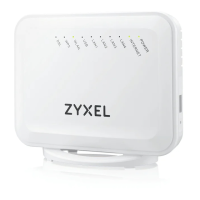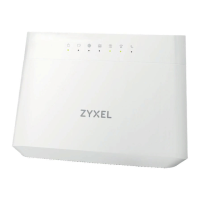Chapter 9 VDSL Setup
VES1724-56 User’s Guide
107
Max SNR Margin Enter the maximum SNR (Signal to Noise Ratio) margin allowed on the line. When the
actual SNR margin is going to reach this specified value, this mechanism forces
connected CPE device(s) to lower its transmission power level and maintains the actual
SNR margin equal to or less than this value. Select noLimit to turn this mechanism off.
Target SNR Margin Enter the target upstream and downstream SNR (Signal to Noise Ratio) margin.
Min SNR Margin Enter the minimum upstream and downstream SNR margin accepted on the line to
which this profile applies.
Bitswap Select On to allow on-line bits and power (for example, margin) reallocation among the
allowed sub-carriers without service interruption or errors. This helps to keep
transmission data rate on a high SNR VDSL line.
Select Off to disable it.
Max Rx Power Enter the maximum receiving power in dBm for UpStream traffic. Select noLimit if
there is no limit.
Max Tx Power Enter the maximum transmission power in dBm the Switch uses for DownStream
traffic. Enter the maximum transmission power the CPE uses for UpStream traffic.
Min Overhead Rate Enter the minimum transmission rate (4~248 kbps) reserved for a line’s overhead
channel. Both the Switch and CPE device use the overhead channel of a line to get VDSL
transmission statistics with each other.
Limit PSD Mask To reduce the impact of interference and attenuation, ITU-T G.993.2 specifies a limit
PSD mask that limits the VDSL2 transmitters PSD at both downstream and upstream.
Transmission
Mode
Select an appropriate transmission standard (according to your territory) you want to
apply for this profile. At the time of writing, the Switch supports G.993.2 Annex A
mode for countries which follow the North American VDSL2 standard.
ADSL/VDSL
Protocol
Select the ADSL (G.992.1, G.992.2, G.992.3, G.992.5, ANSI, and ETSI) and VDSL
(G.993.2) protocols this profile uses.
Class Mask A class mask is a combination of several PSD masks according to the PSD mask types.
The available options vary depending on your selection in the Transmission Mode
field. At the time of writing, 998 is the only option in this field when you select G.993.2
Annex A in the Transmission Mode field.
Limit Mask Select a downstream limit mask you want the Switch to use.
US0 Mask Select a limit mask you want the Switch to use for the upstream band 0.
UPBO UPBO (Upstream Power Back-Off) mitigates far-end crosstalk (FEXT) caused by
upstream transmission on shorter loops to longer loops. See UPBO
on page 98.
Select Auto to enable UPBO and CPE devices’ PSD adjustment based on the negotiation
result with the Switch.
Select Override to force CPE devices to use the electrical length defined by the Switch
(in the UPBOKL field below) to compute their UPBO. See UPBO/DPBO Electrical Length
on page 100.
Select Disable to turn UPBO off.
Enter variable A and B values of upstream band 1 and band 2 for UPBO PSD mask
calculation.
UPBOKL Specify the electrical length (0~128 dB) of the cable between the Switch and CPE
devices. See UPBO/DPBO Electrical Length on page 100.
UpStream Band
1 ~ 4
Specify 40~80.95 (dBm/Hz) for parameter A which defines the original band shape.
Specify 0~40.95 for parameter B which defines the power back-off degree.
PM Mode Select allowTransitionsToIdle to have the Switch or CPE devices autonomously enter
an idle state for power management (PM).
Table 34 VDSL Line Profile Setup (continued)
LABEL DESCRIPTION
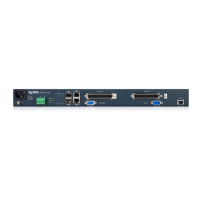
